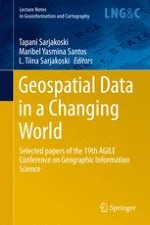2016 | OriginalPaper | Buchkapitel
Personalizing Walkability: A Concept for Pedestrian Needs Profiling Based on Movement Trajectories
verfasst von : David Jonietz
Erschienen in: Geospatial Data in a Changing World
Aktivieren Sie unsere intelligente Suche, um passende Fachinhalte oder Patente zu finden.
Wählen Sie Textabschnitte aus um mit Künstlicher Intelligenz passenden Patente zu finden. powered by
Markieren Sie Textabschnitte, um KI-gestützt weitere passende Inhalte zu finden. powered by
